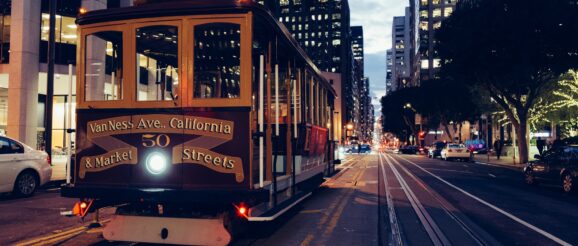Nine American cities rank among 60 global metros positioned for transportation innovation

The transportation landscape in cities across the nation is evolving as rapidly as is the technology that’s driving the change—and some communities are more prepared for future adaptations than others. A new report from the Oliver Wyman Forum and the University of California, Berkeley ranks nine American cities among 60 metro centers around the globe that are best positioned for transportation innovation.
Given the historic investment that’s been made by the Biden Administration into local infrastructure during the pandemic, communities have an opportunity to capitalize on the opportunity and prepare for change by making “modern mobility systems a core part of their strategies. Efficient and equitable mobility networks are key engines of urban vitality and sustainability,” an introduction to the report says.
Leading the 60 global cities based on a “diverse set of metrics,” San Francisco, Calif. is ranked first globally as the city best positioned to take advantage of mobility innovations.
The city is ranked because of its proximity to Silicon Valley and major universities, and because it has embraced “the new technology emerging from these institutions, in particular autonomous driving systems. In 2022, San Francisco became one of the world’s first cities to allow commercial operations of self-driving cars.”
San Francisco is followed by Stockholm, Sweden; Helsinki, Finland; Singapore; and Zurich, Switzerland.
Cities were ranked based on six attributes, according to a brief about the findings. Those attributes are: integration and inter-modality, which is important to create seamless travel across communities; accessibility; sustainability; innovation; collaboration; and resilience. Two sub-indexes were also included in the study, one for sustainability and another for public transit, which “is by far the most eco-friendly way to enable large groups of people to move around and can help businesses attract the workers they need and keep city centers buzzing with activity,” the report says. Notably, no American cities ranked in either of those sub-indexes, including San Francisco, even though it placed first overall. Most of the top cities for public transit are European.
“San Francisco does not feature in the top 15 in Sustainable Mobility or Public Transit rankings. The city’s limited number of public transit stations means long walks to reach them and relatively low usage. Despite attempts to mitigate the threat of natural disasters, such as forest fires and earthquakes, San Francisco’s legacy infrastructure means that its mobility systems are still inadequately prepared to meet these challenges,” the introduction says.
Along with the ranking, the index highlights four trends that are expected to drive future innovation: connectivity, a changing landscape for public transportation, which has been impacted by more people working from home, electrification, and automation.
The nine American cities that made the 60 global cities appear in the gallery above in the order they appear on the global list. Visit the Oliver Wyman Forum’s website to view the complete report and a full list of the 60 global cities.
